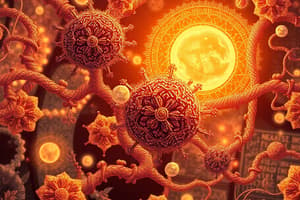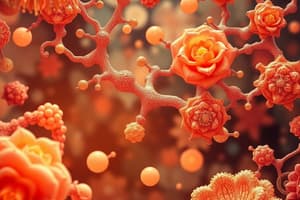Podcast
Questions and Answers
What is a catalyst?
What is a catalyst?
A substance that speeds up the attainment of equilibrium.
Does a catalyst change the position of the reaction's equilibrium?
Does a catalyst change the position of the reaction's equilibrium?
False (B)
What does a catalyst do?
What does a catalyst do?
Lowers the amount of energy needed for the reaction to proceed.
Define substrates.
Define substrates.
What does it mean for an enzyme to exhibit stereospecificity?
What does it mean for an enzyme to exhibit stereospecificity?
What is the most important part of enzyme specificity?
What is the most important part of enzyme specificity?
What is reaction specificity?
What is reaction specificity?
What is an important property that distinguishes biological catalysts from those encountered in a chemistry lab?
What is an important property that distinguishes biological catalysts from those encountered in a chemistry lab?
What was the first enzyme that was crystallized and proved to be a protein?
What was the first enzyme that was crystallized and proved to be a protein?
All enzymes have been shown to be __________ or __________________.
All enzymes have been shown to be __________ or __________________.
What are the four main properties of enzymes?
What are the four main properties of enzymes?
What are the six classes of enzymes?
What are the six classes of enzymes?
What do oxidoreductases catalyze?
What do oxidoreductases catalyze?
What do transferases catalyze?
What do transferases catalyze?
What do hydrolases catalyze?
What do hydrolases catalyze?
What do lyases catalyze?
What do lyases catalyze?
What do isomerases catalyze?
What do isomerases catalyze?
What is the simplest enzymatic reaction?
What is the simplest enzymatic reaction?
What do ligases catalyze?
What do ligases catalyze?
What are ligases usually referred to as?
What are ligases usually referred to as?
Kinetic experiments examine the relationship between?
Kinetic experiments examine the relationship between?
What does the rate equation reflect?
What does the rate equation reflect?
In a second order reaction, the rate is determined by the concentration of?
In a second order reaction, the rate is determined by the concentration of?
What is the enzyme-substrate complex?
What is the enzyme-substrate complex?
What does the overall rate of an enzyme reaction depend on?
What does the overall rate of an enzyme reaction depend on?
What do enzyme assays measure?
What do enzyme assays measure?
Why is the formation and dissociation of ES complexes very rapid?
Why is the formation and dissociation of ES complexes very rapid?
When is the substrate chemically altered?
When is the substrate chemically altered?
How does enzyme kinetics differ from simple chemical kinetics?
How does enzyme kinetics differ from simple chemical kinetics?
What relationship does the Michaelis-Menten equation describe?
What relationship does the Michaelis-Menten equation describe?
What is the shape of a Vo versus [S] curve?
What is the shape of a Vo versus [S] curve?
Name three statements about the Km (Michaelis Constant).
Name three statements about the Km (Michaelis Constant).
What are kinetic mechanisms?
What are kinetic mechanisms?
What do sequential reactions require?
What do sequential reactions require?
In ping-pong reactions, a product is released _______ all the _________ are bound.
In ping-pong reactions, a product is released _______ all the _________ are bound.
What is an inhibitor?
What is an inhibitor?
How do reversible inhibitors bind to enzymes?
How do reversible inhibitors bind to enzymes?
What are the basic types of reversible inhibition, and how are they distinguished?
What are the basic types of reversible inhibition, and how are they distinguished?
Describe the effect of competitive inhibition on Km and Vmax.
Describe the effect of competitive inhibition on Km and Vmax.
Describe the effect of uncompetitive inhibition on Km and Vmax.
Describe the effect of uncompetitive inhibition on Km and Vmax.
Describe the effect of noncompetitive inhibition on Km and Vmax.
Describe the effect of noncompetitive inhibition on Km and Vmax.
What is an irreversible enzyme inhibitor?
What is an irreversible enzyme inhibitor?
How does irreversible inhibition typically occur?
How does irreversible inhibition typically occur?
What is an important use of irreversible inhibitors?
What is an important use of irreversible inhibitors?
Which organic phosphorus compound irreversibly inhibits serine protease chymotrypsin?
Which organic phosphorus compound irreversibly inhibits serine protease chymotrypsin?
What is the major biological action of the original organophosphorus nerve gases?
What is the major biological action of the original organophosphorus nerve gases?
How can enzymes have rapid control of enzyme regulation rates?
How can enzymes have rapid control of enzyme regulation rates?
What do regulated enzymes respond to in order to adjust the rates of its metabolic processes?
What do regulated enzymes respond to in order to adjust the rates of its metabolic processes?
When do regulated enzymes become more active catalysts?
When do regulated enzymes become more active catalysts?
When do regulated enzymes become less active?
When do regulated enzymes become less active?
Inhibition of what conserves both material and energy?
Inhibition of what conserves both material and energy?
What are allosteric enzymes?
What are allosteric enzymes?
Why do allosteric enzymes not exhibit typical Michaelis-Menten kinetics?
Why do allosteric enzymes not exhibit typical Michaelis-Menten kinetics?
What are affinity labels?
What are affinity labels?
What are two methods of regulation?
What are two methods of regulation?
What are the general properties of allosteric enzymes?
What are the general properties of allosteric enzymes?
What are the two theories of allosteric regulation?
What are the two theories of allosteric regulation?
How can the activity of an enzyme be modified?
How can the activity of an enzyme be modified?
Regulation by ________________________________ is usually slower than allosteric regulation.
Regulation by ________________________________ is usually slower than allosteric regulation.
Covalent modification of regulated enzymes must be _____________
Covalent modification of regulated enzymes must be _____________
What is the most common type of covalent modification?
What is the most common type of covalent modification?
What are the metabolic advantages of multi-enzyme complexes and multifunctional enzymes?
What are the metabolic advantages of multi-enzyme complexes and multifunctional enzymes?
What is the best-characterized example of channeling?
What is the best-characterized example of channeling?
Flashcards are hidden until you start studying
Study Notes
Properties of Enzymes
- Catalysts speed up the attainment of equilibrium without changing it.
- Catalysts lower the activation energy needed for reactions.
- Substrates are specific reactants that enzymes act upon.
- Stereospecificity refers to enzymes acting only on a specific stereoisomer of the substrate.
- Reaction specificity is vital as it prevents the formation of unwanted by-products.
Enzyme Classification and Properties
- Enzymes can be proteins or protein-cofactor complexes.
- Key enzyme properties include:
- Acting as catalysts
- Catalyzing highly specific reactions
- Coupling reactions for energy transfer
- Being subject to regulatory mechanisms
- Six classes of enzymes:
- Oxidoreductases (catalyze oxidation-reduction)
- Transferases (catalyze group transfers with coenzymes)
- Hydrolases (catalyze hydrolysis reactions)
- Lyases (catalyze non-hydrolytic, non-oxidative eliminations)
- Isomerases (catalyze isomerization reactions)
- Ligases (catalyze joining of substrates, often utilizing ATP)
Enzyme Kinetics
- Kinetic experiments assess the relationship between product formation and reaction conditions.
- The rate equation reflects the dependence of reaction velocity on substrate concentration.
- An enzyme-substrate complex forms when substrates fit into the enzyme's active site.
Michaelis-Menten Kinetics
- The Michaelis-Menten equation describes the initial velocity of a reaction in relation to substrate concentration, forming a rectangular hyperbola.
- The Michaelis constant (Km) reflects substrate affinity and is the substrate concentration at half of the maximum velocity (Vmax).
Enzyme Regulation
- Regulation of enzyme activity can occur through reversible modulation via environmental signals.
- Allosteric enzymes have regulatory sites distinct from active sites and can exhibit sigmoidal reaction curves due to cooperative binding.
- Two primary regulation methods: non-covalent allosteric regulation and covalent modification, with phosphorylation being the most common type of covalent modification.
Inhibition Mechanisms
- Inhibitors are small molecules that can reversibly bind to enzymes, affecting their activity.
- Types of reversible inhibition include:
- Competitive (increases Km, Vmax unchanged)
- Uncompetitive (lowers Km and Vmax, ratio of Vmax/Km unchanged)
- Noncompetitive (Km unchanged, Vmax lowered)
- Irreversible inhibitors form stable covalent bonds, often to the active site, removing active enzymes from the population, as seen with nerve gases inhibiting acetylcholinesterase.
Enzyme Complexes and Channeling
- Multi-enzyme complexes enhance the efficiency of metabolic pathways through metabolite channeling.
- Channeling protects intermediates from degradation and increases reaction rates, exemplified by the enzyme tryptophan synthase.
Studying That Suits You
Use AI to generate personalized quizzes and flashcards to suit your learning preferences.




